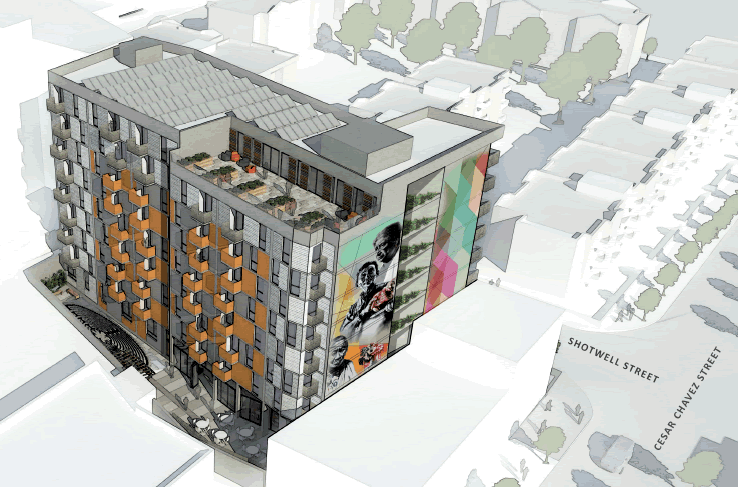Rather than include any affordable housing onsite, the development team behind “Vida” at 2558 Mission Street deeded the industrial building at 1296 Shotwell Street to the City in 2012.
And while Vida opened in late 2014, the plans for 1296 Shotwell remain on the boards.
As proposed, the one-story building will be razed and a 9-story development with 96 below market rate units for seniors, including 20 units for the formerly homeless, will rise up to 85-feet in height upon the Shotwell Street site.
In addition to the 96 units of affordable housing, the proposed development includes a little over 5,000 square feet of community and office space and 5,500 square feet of outdoor space across the ground floor, second floor and roof terrace.
And in lieu of a garage, a dedicated vanpool drop off is proposed in front of the building’s lobby, along with bike racks and seating.
But as noted in the City’s preliminary review of the project plans, which were drafted by Herman Coliver Locus Architecture, the site is currently only zoned for development up to 65 feet in height.
As such, the 1296 Shotwell Street parcel will either have to be legislatively upzoned or the City’s proposed Affordable Housing Bonus Program (AHBP) will need to be passed in order for the development to proceed. Once approved and permitted, it will take another two years to build. And at best, we’re looking at 2018 to 2019 before the units are ready for occupancy.




Not bad looking for what it is but why must we suffer the ongoing tyranny of cubic architecture. It’s 100% straight lines and right angles. If even 5% of the straight lines converted to curves marks or waves, or anything other than dead flat horizontal and vertical change and soften the feel of the building.
For example, the railings on the balconies could all be of some kind of uniform or variable curve.
sorry for the grammar errors, editor, this iPad dictation is not ready for prime time. I will stop using it in future posts.
That tends to be a far more expensive design choice no? They’re clearly thinking beyond a generic rectangular prism, but honestly straight lines are easier to design. There’s less need to custom fabricate curved components.
“Cubic architecture”? What is that? as an architect, that’s a pretty new description to me. perhaps you mean Cubism within the art world?
Nonetheless, I’m trying to listen, trying to understand your desire for curves or waves: Why? Do you think it’s going to make the building nicer, cuter, friendlier, cheaper, more desirable? What then?
And for pure cost, generally any form curved or non-linear is going to cost more to fabricate AND to install. So this could add to the cost of the project, in turn adding to the incremental cost of rents.
I see no logical reason why curves or waves are needed, except that you may like them.
Yeah, what’s with all these rectangular shaped structures all over the place? Why would anyone want to build something like that?
Much better to make a Buckminster Fuller style geodesic dome. Or how about a yurt?
Yes, we have far too few yurts in San Francisco.
The project can invoke the State-based density bonus rules. They don’t have to wait for San Francisco.
The cost of litigating that out would be rough, even if they eventually prevail.
Why does no one understand that the states affordable density bonus is already law and can be invoked now, regardless of what SF decides to implement
I have been saying that for a while, but recently was enlightened as to why SF developers have been very reluctant to demand the state density bonus.
The planning department has been telling developers they cant use it till things are sorted out with AHBP and other overlapping rules. Legally shady, but they are under pressure from CCHO and the neighborhood groups who have also threatened that they would cause extreme legal and meeting pain if any state density bonus projects came up.
Since there is no time limit under which cities must answer density bonus requests, this puts the developers into a state of limbo where the city has a lot of power. Basically, its a great law, but in SF, with our system as it is, if someone like Peskin is giving you stink-eye, it can de facto kill your project.
A large proportion of Oakland proposals are requesting the density bonus. Light the path, Eastbay.
God I hate Peskin so much…..to me, he represents everything wrong with SF. A kernel of good intentions wrapped with a super thick layer of idiocy, coated with gross misunderstandings of real world economics.
yes, they could invoke the state density bonus, but it probably won’t give them the extra 3 stories they’re looking for. The state program maxes out at a 35% bonus volume/square footage.
35% more than the volume allowed under 65′ height limit is presumably not a 9-story building. That approach would probably net them an extra two stories. That’s one reason why the local program is proposed – to offer more than the state provides for, along with getting more in return.
My understanding is the state density bonus will get them 2 extra floors. I’m assuming this one requires 3 (65′ up to 95′), which is what was offered by the 100% affordable option under AHBP.
That approach to bike parking is a little different.
On the one hand, it’s convenient, which is more than you can say for some projects where you have to push (or pull) open multiple heavy doors while wheeling your bike.
On the other hand, though, it looks like it’s pretty much a public thoroughfare (will you even need a key to enter?) and that’s not great for security. I feel like you wouldn’t leave any sort of valuable bike there.
Senior housing … with bike racks
This is either ironic or a BIG U-turn. Both CCDC and MEDA have publicly opposed the AHBP, local density bonus plan. Have they recently discovered its virtues?
UPDATE: Hearing for Affordable Mission District Development Set